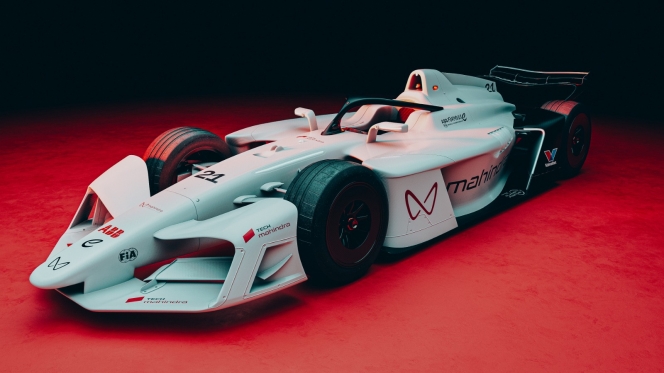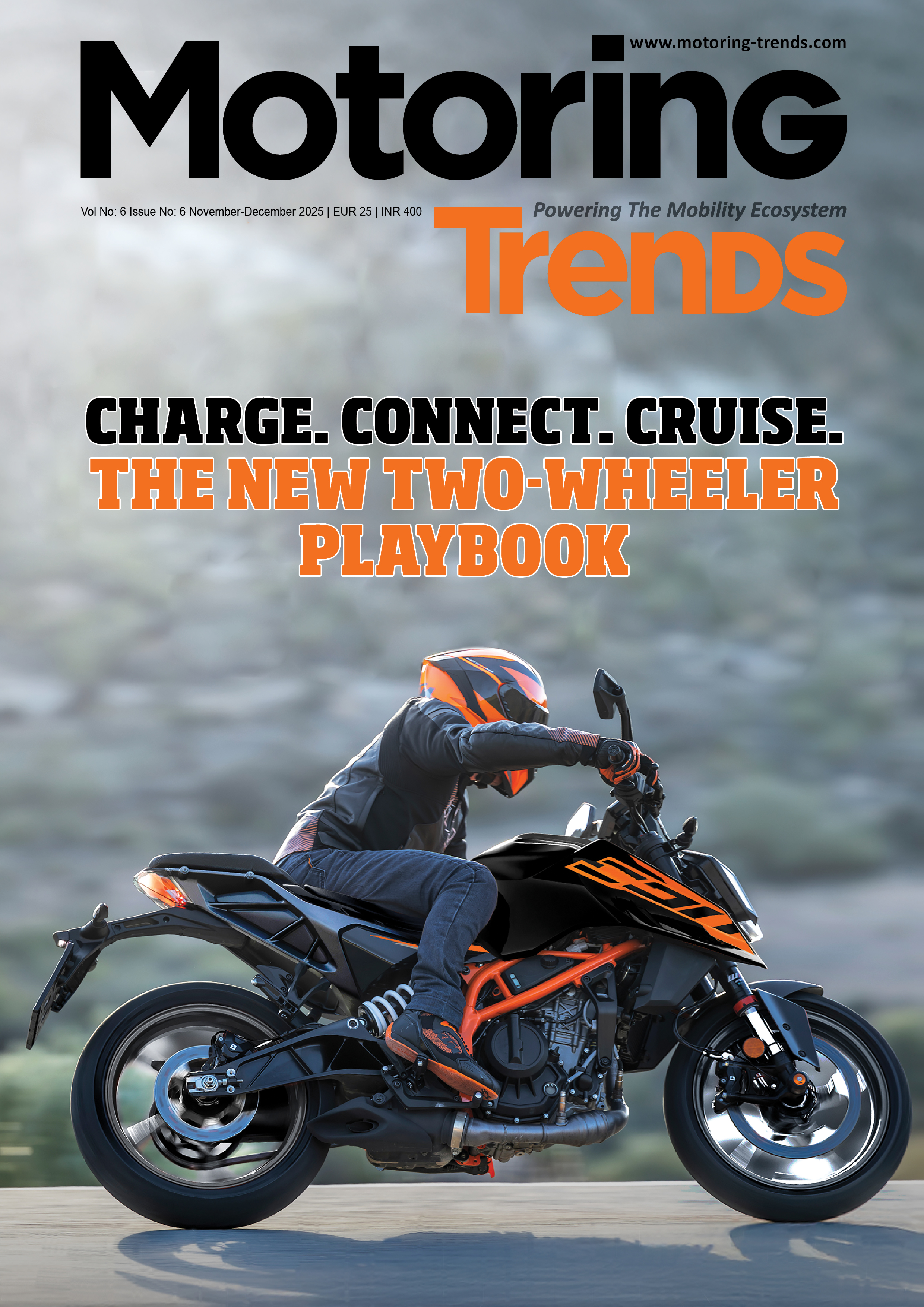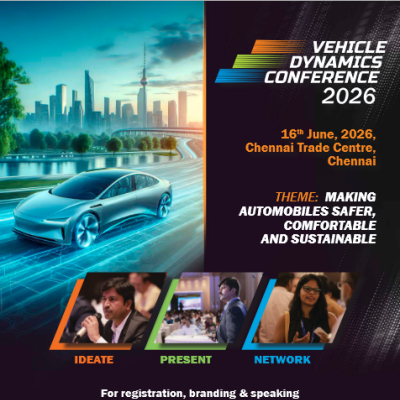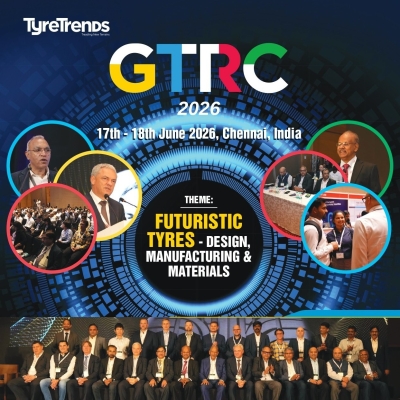Our Solutions Help To Simplify V Cycle Of Automotive Development Process
- By Sharad P Matade
- June 22, 2021

Over the last three decades, Vector has been supplying tools and services that give engineers the decisive advantage to make challenging and highly complex designs and develop automotive products as simple and manageable as possible. Today, the company is working on various fronts from e-mobility to connectivity, cyber security to ADAS and will continue to work on the new areas which will drive the future of mobility. “Vector is also working on identifying the challenges that a customer could face in the future in the context of these trends and is working as a partner with the customers to overcome these challenges,” said Chandra Nataraja, Managing Director, Vector Informatik India. Nataraja also emphasises the need of ‘real R&D development’ at the local level in India, instead of being followers and adapters.

Q) We are coming across the word “complexity” often in the automotive industry? How does Vector help in simplifying the process in engineering, design, testing, validation and calibration?
Chandra Nataraja: At Vector Informatik, more than 3,000 employees across 31 locations worldwide support manufacturers and suppliers of the automotive industry with a professional platform of tools and software components. Our solutions are used by engineers of automotive OEMs, Tier-1 suppliers and other software organisations undertaking the development of automotive electronics.
There is increased complexity in the automotive space, especially with the software running in cars, for which development teams need to have an overview of their ideas being realised into technologies. There is a lot of toolchain and structure development, not to mention the standards that are being adopted. Vector is a part of several standardisation groups and offers solutions across the complete V cycle of automotive development process, including system engineering, design, testing, validation and calibration, which helps to simplify the processes for the customers.
To elaborate further, the ECU testing tools from Vector support in the implementation of simulation and test environments in an efficient way. Regardless of the task in the development process, the Vector testing tools provide a scalable and re-usable solution from pure SIL simulations to HIL testing with functional acceptance tests – for all types of vehicles including internal combustion engine, a hybrid or a purely electric vehicle. Similarly, for calibration, we provide software and hardware solutions which cover all requirements throughout the entire development process, right from function development through bypassing and rapid prototyping solutions to test bench applications and test drives during trials and in series production.
We also offer solutions to engineers in other application areas such as advanced driver assistance systems (ADAS), autonomous driving, connected vehicles and electric vehicles. The company puts together solutions and provides customers with toolchain to develop, test, calibrate and validate software that is being developed for such applications.
Q) What are the current trends in the automotive industry for which the company is developing solutions?
Chandra Nataraja: Vector follows automotive trends closely, with the principle for the company being that it does not develop solutions in isolation, but rather works with customers as partners.
E-mobility is one of the major trends today and for electric mobility to enter mass market, smart charging is a key solution. The term smart charging is used for charging systems of electric or hybrid vehicles according to various standards like ISO 15118, DIN SPEC 70121 and SAE J2847/2. Vector supports developers of on-board charging ECUs in the vehicle, charging stations and induction charging systems with extensive test systems and bespoke ECU software. Using Vector test solution for smart charging, customers can test on-board charging ECUs without having to operate a real charging spot. Vector also offers solutions for testing of charging stations, E-Mobility Measurement and software stack for rapid development of charging ECUs, which supports all international standards including CCS, GB/T and CHAdeMO. This helps customers develop their software quickly and cost effectively.
 Another area of focus is connected vehicles, where Vector is looking at extending the domain beyond the car, at the areas where it can offer standardisation. There is a large amount of data collected from the car when talking about connectivity, and the company is looking at cloud solutions in managing this data.
Another area of focus is connected vehicles, where Vector is looking at extending the domain beyond the car, at the areas where it can offer standardisation. There is a large amount of data collected from the car when talking about connectivity, and the company is looking at cloud solutions in managing this data.
This also brings us to cyber security, where OEMs and applied partners are analysing if there is enough security of information inside the automobile. Vector has developed solutions related to remote updating of software, for which its understanding of the vehicle network is helping us to see how this can be connected with the IT world.
Autonomous Driving is another trend towards which Vector is carrying out development work, in partnership with BASELABS. BASELABS has algorithms related to ADAS for autonomous driving, and with Vector’s calibration product line aligned to it, we have an entire package which supports both the development and validation of ADAS.
Our tool set for testing and calibration has been developed to accommodate future vehicle technologies, and also extend it to multiple networks in the vehicle. Apart from developing innovations based on market trends, Vector is also working on identifying the challenges that a customer could face in the future in the context of these trends and is working as a partner with the customers to overcome these challenges.
Q) With the growing penetration of electronics in vehicles, how do you see the business opportunities for the company?
Chandra Nataraja: Since last 30 years, Vector has been a capable partner in the development of automotive electronics. Satisfied and successful customers are our motivation, and we work to ensure that our customers achieve an increase in value in their work that we can also be proud of. Driven by our passion for technology, we develop solutions which relieve engineers of their demanding tasks and our focus continues to be on providing products to customers for developing embedded systems so that they can develop solutions which will drive the future of mobility.
We see the business opportunities increasing with our existing customers as they look towards future challenges and opportunities. Also, the current trends have brought in new technology players in the automotive ecosystem, and we look forward to working with them as their reliable and technically competent partner.
Q) How do you see the collaborative approach, especially with high-tech companies?
Chandra Nataraja: Presently, we are already collaborating with multiple high-tech companies in Europe and USA. We do see the potential to collaborate with Indian Tier-1s, Tier-2s and service organisations, especially in the EV space. India is poised to develop a unique ecosystem within the electric vehicle segment where all these companies will play a key role, and we look forward to working as partners with everyone who will develop the future of mobility.
We continue to explore synergies with agile companies and our technology, which can be seen in our efforts to foray into areas other than automotive where we can add value as partner to customers and collaborate to develop technology solutions.
 Q) What is the role of the Indian entity in Vector’s global business?
Q) What is the role of the Indian entity in Vector’s global business?
Chandra Nataraja: Vector Informatik India Private Limited is a 100 percent subsidiary of Vector Informatik GmbH and is headquartered at Pune with offices in Bengaluru, where more than 100 technical experts and subject matter specialists support the customers in automotive ecosystem with their challenges and provide customised solutions as per their development and testing needs.
We work closely with all global and local customers based in India, those who have technical teams and presence in India – to understand their development needs and provide solutions across application areas. Dedicated support team in India is available to the customers for all technical queries’ resolution, while we also facilitate the training needs of the customer locally. We also have a test services team which supports the customers with their customised project requirements related to test systems.
Q) What significance does AUTOSAR have for Vector?
Chandra Nataraja: We see that AUTOSAR is a standard that is widely adopted across the globe and the automotive market in India has also seen good adaptation towards AUTOSAR.
Vector has many years of experience in AUTOSAR and provides a comprehensive AUTOSAR Classic solution called as MICROSAR. It consists of the MICROSAR RTE (runtime environment) and MICROSAR basic software modules (BSW), which cover all aspects of the AUTOSAR standard and include many useful extensions. MICROSAR is widely used by several OEMs globally, and in India, many customers have MICROSAR stack running in their cars as the Tier-1s have used Vector AUTOSAR solutions.
 Exida, the internationally recognised specialist for functional safety, has verified and independently certifies that the AUTOSAR 4 basic software from Vector fulfills the requirements of ISO 26262 up to the ASIL D level – it is called as MICROSAR Safe. MICROSAR Safe is the result of many years of experience in the field of functional safety and it helps customers integrate safety related functions into their ECU and develop AUTOSAR-based applications as per the functional safety standard, ISO 26262.
Exida, the internationally recognised specialist for functional safety, has verified and independently certifies that the AUTOSAR 4 basic software from Vector fulfills the requirements of ISO 26262 up to the ASIL D level – it is called as MICROSAR Safe. MICROSAR Safe is the result of many years of experience in the field of functional safety and it helps customers integrate safety related functions into their ECU and develop AUTOSAR-based applications as per the functional safety standard, ISO 26262.
In 2017, the AUTOSAR development partnership added a new standard to its line-up that is based on POSIX operating systems: the “AUTOSAR Adaptive Platform”. Adaptive MICROSAR is the Vector solution for vehicles with an E/E architecture based on the AUTOSAR Adaptive Platform. It complements the proven MICROSAR with basic software for the AUTOSAR Adaptive Platform, which is optimised for highly automated driving, multimedia applications and networking services.
Thus, we at Vector provide field-proven AUTOSAR solutions which are tuned to the customer needs – offering a comprehensive range of design and development tools, ECU software and services around AUTOSAR. We are committed to support customers going ahead for all requirements around AUTOSAR.
Q) What are the new areas that Vector is now focusing on?
Chandra Nataraja: We continue to work closely as partners with customers to identify the new areas which will drive the future of mobility. We spoke about the current trends earlier and Vector continues its focus around those, including e-mobility, connectivity, cyber security and ADAS.
There is good amount of work going on towards the development of new connectivity-related technologies, as well as in cloud solutions. A lot of research is being undertaken on identifying the appropriate connectivity technologies for vehicle networks.
There are many new start-ups and technology players who are coming up as new trends emerge, across India and globe. Through our subsidiary VVC Vector Venture Capital GmbH, we continue to accompany young companies in their first steps by providing required support in different ways to these new entrants.
Vector Consulting Services is another such effort from our end to add value based on benchmarks, methodology and Vector experience in different toolchains. Through Vector Consulting, we aim to support customers for optimising the engineering and product development.
Q) What are the challenges in the industry?
Chandra Nataraja: Automotive electronics has come a long way and continues to evolve with trends and technologies like connected vehicles and autonomous driving, which we discussed earlier. Thus, one of the main challenges to the automotive ecosystem is to develop vehicles which are as secured as they are connected. The idea is to think more about the abuse cases than the use cases during development, which will ensure that the vehicles on the road continue to be reliable and secured.
On the development side, standardisation at the E/E Architecture level is the need of the hour which will allow for effective implementation of use cases like customisations amongst others.
We must understand that it takes considerable time and thought to bring new technologies to fruition and the process is at times slow. We thus need real R&D development at the local level in India, instead of being followers and adapters – this will allow for faster turnaround times and quicker technology adoption within the Indian automotive industry. (MT)
- Hagerty UK
- Vehicle Excise Duty Exemption
- VED Exemption
- Historic & Classic Vehicles Alliance
- Classic Cars
UK Chancellor Maintains Vehicle Excise Duty Exemption For Classic Cars
- By MT Bureau
- November 27, 2025

The UK's cherished classic car community can finally breathe a collective sigh of relief. The decisive action by Chancellor Rachel Reeves in the Autumn Budget to maintain the Vehicle Excise Duty (VED) exemption for vehicles over 40 years old has ended a prolonged period of uncertainty, securing a stable future for this vital sector. Mark Roper, Managing Director of Hagerty UK, welcomed this clarity, noting that the confirmed freeze on fuel duty further solidifies a supportive environment for owners. He underscores that this is a significant win for the GBP-7.3-billion industry that supports over 100,000 jobs and contributes GBP 3 billion annually to the UK economy, all while championing an inherently sustainable form of motoring.
This perspective on sustainability is reinforced by Dale Keller, CEO of the Historic & Classic Vehicles Alliance (HCVA), who affirms that the tax exemption logically aligns with environmental objectives. Classic vehicles, preserved as moving heritage, have a negligible lifecycle carbon footprint compared to new manufacturing and are driven infrequently. The original principle of the exemption remains valid, as applying a modern tax to these rarely used assets would be inequitable.
Alongside the VED news, the Chancellor confirmed the continuation of the MOT exemption for classic cars, though this will remain under review. On this point, Roper of Hagerty UK strikes a note of caution, observing that many within the industry advocate for an annual roadworthiness check. He notes that a great number of responsible classic owners voluntarily submit their vehicles for an MOT each year, valuing the independent assurance of safety and mechanical integrity it provides.
For Hagerty UK, as a specialist insurer deeply embedded in this world, the government’s affirmation is a powerful endorsement of the sector's cultural and economic value. Through its vibrant Clubhouse at Bicester Heritage and unique events like RADwood, Hagerty is actively fostering this passionate community. Similarly, the HCVA continues its mission to protect and promote the diverse ecosystem of specialists, restorers and businesses that form the backbone of this multi-billion-pound industry, ensuring its legacy for generations to come.
Mahindra Racing Extends Formula E Involvement With GEN4 Manufacturer Commitment
- By MT Bureau
- November 26, 2025

Mahindra Racing has solidified its long-term future in electric motorsport by confirming its manufacturer commitment to the GEN4 era of the ABB FIA Formula E World Championship, starting in 2026/27. This announcement, made during the unveiling of its new M12Electro race car in India, extends a relationship that began in 2013 when Mahindra stood as both a founding team and the first OEM to join the all-electric series.
The team's current trajectory underscores the significance of this pledge. Following a dramatic 18-month transformation under CEO and Team Principal Frederic Bertrand, Mahindra Racing has evolved from a backmarker into a consistent front-runner. This resurgence was powered by the redesigned M11Electro, in which drivers Nyck de Vries and Edoardo Mortara collectively secured five podium finishes in Season 11, catapulting the squad to a stellar fourth place in the world championship. The newly launched M12Electro is the intended vehicle to maintain this status as a top-five contender and a regular threat for podium positions in the forthcoming season.
The technical landscape for GEN4 promises to further electrify the sport. The next-generation cars will boast a peak race power of 450 kw, with a potent 600 kw available in ATTACK MODE to empower aggressive overtaking. Enhanced strategic possibilities will come from a race energy capacity of up to 55 kWh and a remarkable 700 kw of regenerative braking. In a continued commitment to sustainability, the GEN4 chassis will be produced from 100 percent recyclable materials and will feature two distinct aerodynamic configurations – high-downforce for qualifying and low-downforce for races – to optimise performance.
Mahindra's ambition is to leverage this new regulatory chapter to build on its renewed momentum, chase incremental gains and establish itself as a confirmed championship contender against elite manufacturers like Porsche and Jaguar. This competitive platform also serves a broader purpose, aligning with the Mahindra Group’s sustainability initiatives. The team, the first in Formula E to earn the FIA’s Three-Star Sustainability Accreditation, has embarked on its ‘Planet Positive’ programme. This initiative is dedicated to driving positive impact in communities and economies, accelerating climate solutions and using the intersection of sport and technology as a catalyst for a better future.
R Velusamy, Chairman, Mahindra Racing, said, "Mahindra Racing has always been a symbol of our commitment to the Race to Road journey – where cutting-edge innovation on the track directly shapes the clean, intelligent and high-performance mobility solutions we deliver to customers. Formula E is a powerful platform for innovating new technology, giving us the ability to experiment, learn and advance electric powertrain efficiency, sustainable materials and software intelligence. As we step into the GEN4 era, our ambition only grows stronger. Continuing this journey till 2030 is a testament to our belief in the sport, in electrification and in India’s role in leading global sustainable mobility. We are proud to champion this future, and GEN4 represents an exciting new chapter for Mahindra Racing and the Mahindra Group.”
Frederic Bertrand, Team Principal, Mahindra Racing, said, “I’m delighted to share this announcement that Mahindra Racing will remain in Formula E as a manufacturer for the GEN4 era. As a team, we have been on a fantastic journey over the past two seasons. What we have built and achieved as a group has been exceptional, and with this announcement, we now have the platform to keep growing and developing and achieve even greater success in the future. None of this would be possible without our colleagues across the Mahindra Group. They have bought into the project and the vision, and we will keep working hard to not only make India proud but also showcase exactly why it has the potential to be a major player on the world stage in the automotive and technology industries. Their enthusiasm to ‘Scream Electric’ is hugely inspiring to the whole team, and we will continue to represent them with pride in this next exciting chapter of our Formula E story in the coming years.”
Jeff Dodds, CEO, Formula E, said, “We’re thrilled to confirm Mahindra’s long-term commitment to the GEN4 era of the ABB FIA Formula E World Championship. As one of our founding teams, Mahindra has been with us since the very beginning, consistently championing electric racing and innovation. Their bold vision for sustainable mobility and continued investment in advanced EV technology perfectly align with Formula E’s mission. Mahindra’s enduring presence not only strengthens our position in a key market but also reinforces Formula E’s role as a global platform for driving positive change. We’re excited to see what they’ll achieve in this next chapter of performance and progress.”
Marek Nawarecki, Senior Circuit Sport Director, FIA, said, “Following the GEN4 reveal and the really positive sentiment reported, we are pleased to announce Mahindra as the sixth manufacturer to commit to Formula E’s GEN4 era. This is testament to the relevance of the road map we are implementing in Formula E for OEMs. GEN4 underscores just how far the ABB FIA Formula E World Championship has come since 2014 and we are looking forward to continuing this journey with Mahindra as one of the founding teams and partners.”
Mahindra Charts Aggressive Decade Of Growth Across Auto, Farm, CV And Last-Mile Mobility Businesses
- By MT Bureau
- November 21, 2025

Mumbai-headquartered conglomerate Mahindra Group has unveiled an ambitious long-term roadmap across its core mobility and equipment businesses, detailing plans for accelerated growth in the automotive, farm equipment, commercial vehicle and last-mile mobility segments.
The strategy, presented at its Investor Day 2025, underscores the Group’s intent to leverage India’s expanding economy while deepening global market participation.
Mahindra expects its consolidated automotive business to grow 8x between FY2020 and FY2030, driven primarily by a stronger push in sports utility vehicles (SUVs) and light commercial vehicles (LCVs).
The company aims to become the world’s fastest-growing SUV brand. Its product strategy is rooted in new-age platforms such as INGLO and NU_IQ, enhanced digital architecture under MAIA and Adrenox, and continued investment in safety and performance.
At present, Mahindra holds more than 26 percent revenue share in India’s SUV segment as of the first half of FY2026. Strong consumer traction for models including the Thar, XUV700, XUV3XO and the Born Electric (BE) series is expected to support the company’s international expansion to right-hand-drive and left-hand-drive markets across Europe, Australia, Africa and other regions.
Strengthening leadership in LCV segment
The LCV business, where Mahindra commands 54.1 percent volume share in vehicles under 3.5 tonnes (as of H1 FY2026), is set to be another pillar of growth. The product range has broadened through the Supro, MaXX and Veero platforms, including CNG and electric variants. The company is also preparing for wider adoption of lifestyle pickups, led by the upcoming Global Pik Up.
Mahindra’s LCV strategy emphasises best-in-class total cost of ownership, reduced downtime, enhanced comfort and technology integration, with the segment also targeted for eightfold revenue growth during the decade.
Farm business
Mahindra, the world’s largest tractor manufacturer by volume, has outlined plans for threefold revenue growth in its farm equipment division between FY2020 and FY2030.
The Indian tractor market has continued to shift towards higher horsepower models, particularly in the 40–50 HP range. Mahindra aims to consolidate share in this segment through newer platforms including Yuvo Tech+, Swaraj Protek and Next-Gen ranges. Improvements in crop profitability and a more favourable price environment for tractors are expected to support industry expansion.
Mechanisation levels in India remain uneven, with significant headroom in sowing, crop care and harvesting equipment. Mahindra is expanding its farm machinery portfolio while leveraging its extensive dealer network and manufacturing footprint. The division, already a business exceeding INR 10 billion, is poised for rapid scaling.
Mahindra continues to build presence in key global markets:
- Brazil: 8 percent share in the sub-120 HP category, and about 20 percent in sub-50 HP
- North America: more than 10 percent share in sub-20 HP; upcoming launches to deepen penetration
- ASEAN: early progress with about 4 percent share in pilot territories
Electrification, autonomy, precision agriculture and pay-per-use technology services form the next frontier for Mahindra’s farm business.
Targeting Top-Three Position in ILCVs
Following the acquisition of SML Isuzu, Mahindra is advancing a strategy to be among the top-three player in India’s intermediate and light commercial vehicle (ILCV) market. The domestic CV industry is projected to grow from approximately INR 15,000 billion in FY2025 to nearly INR 20,000 billion by FY2031, supported by infrastructure development, logistics modernisation and GST-driven reforms.
Mahindra aims to expand its presence in ILCVs, while pursuing a selective play in the heavy commercial vehicle category. The strategy benefits from combined advantages across product development, sourcing, aggregates, telematics and network coverage. The company expects up to sixfold revenue growth in its CV business during the decade.
Last-Mile Mobility
Mahindra Last Mile Mobility (MLM) is shaping an aggressive electrification-led growth plan, targeting sixfold revenue expansion and a cumulative one million electric vehicles on the road by 2031. EV sales climbed to 78,678 units in FY2025, led by the Treo series, which remains India’s top-selling electric three-wheeler.
The division has:
- Strengthened its engineering capabilities with a 400-member product development team
- Commissioned a new state-of-the-art manufacturing plant in Telangana
- Expanded production capacity two-fold
- Developed proprietary battery, motor and telematics systems
The product roadmap includes advanced electric three-wheelers and electric four-wheelers tailored for last-mile applications, along with plans to expand exports to more than ten markets. Mahindra’s EV fleet has cumulatively saved over 300 million litres of fuel and prevented more than 185 kilo tonnes of carbon dioxide emissions.
Across all mobility segments, Mahindra’s plan is anchored in product leadership, technology integration, capital discipline and global expansion. A stronger focus on electrification, platform consolidation, digital interfaces, manufacturing efficiency and customer-centric service models is expected to underpin the Group’s growth trajectory.
- Murugappa Group
- Arunachalam Vellayan
- Coromandel International
- EID Parry
- EXIM Bank
- Kanoria Chemicals & Industries
- Indian Overseas Bank
Murugappa Group’s Former Chairman Arunachalam Vellayan Passes Away At 72
- By MT Bureau
- November 18, 2025

Chennai-based conglomerate Murugappa Group has announced the passing of Arunachalam Vellayan (1953–2025) following an illness.
Vellayan was the Chairman Emeritus of Coromandel International and the Former Chairman of the Murugappa Group. He is survived by his wife, Lalitha Vellayan, his sons, Arun Vellayan and Narayanan Vellayan, and his grandchildren.
The Former Chairman dedicated several decades to the Group, providing strategic direction across its businesses. His approach to value creation helped strengthen and expand the Group, contributing to its reputation as a respected conglomerate.
He served on the Boards of various Murugappa Group companies, including as Chairman of Coromandel International and EID Parry.
Outside the Group, he served on the Boards of entities such as Kanoria Chemicals & Industries, EXIM Bank and Indian Overseas Bank.






Comments (0)
ADD COMMENT